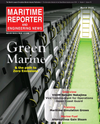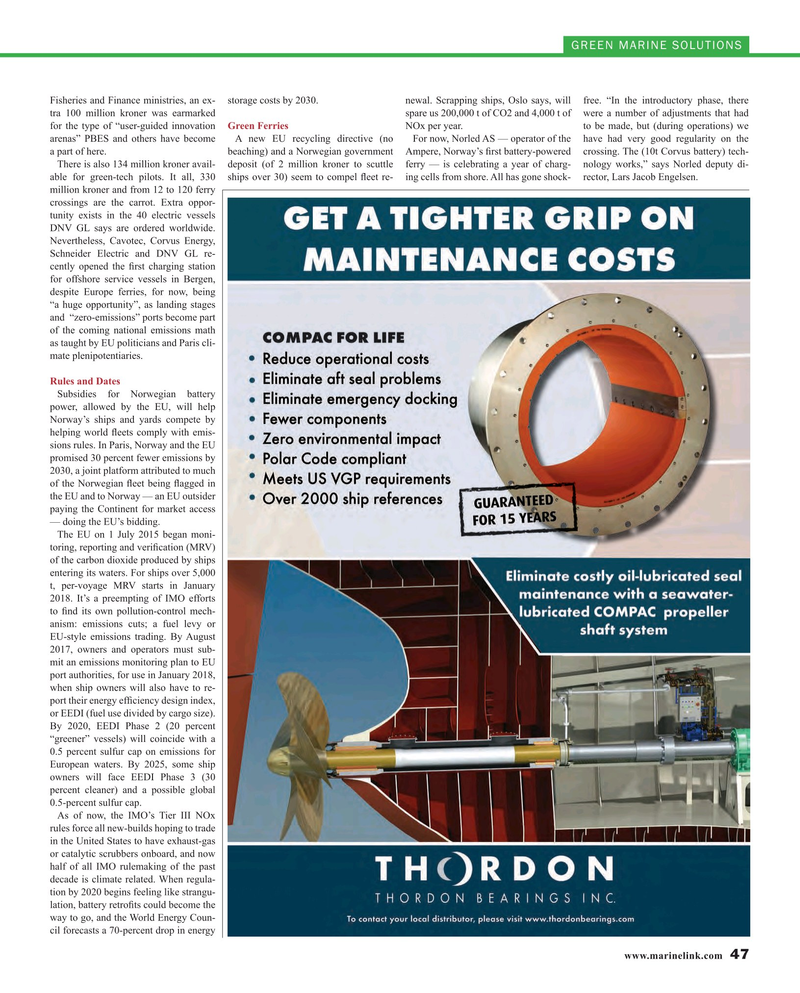
Page 47: of Maritime Reporter Magazine (March 2016)
Green Marine Technology
Read this page in Pdf, Flash or Html5 edition of March 2016 Maritime Reporter Magazine
GREEN MARINE SOLUTIONS
Fisheries and Finance ministries, an ex- storage costs by 2030. newal. Scrapping ships, Oslo says, will free. “In the introductory phase, there tra 100 million kroner was earmarked spare us 200,000 t of CO2 and 4,000 t of were a number of adjustments that had for the type of “user-guided innovation Green Ferries NOx per year. to be made, but (during operations) we arenas” PBES and others have become A new EU recycling directive (no For now, Norled AS — operator of the have had very good regularity on the a part of here. beaching) and a Norwegian government Ampere, Norway’s ? rst battery-powered crossing. The (10t Corvus battery) tech-
There is also 134 million kroner avail- deposit (of 2 million kroner to scuttle ferry — is celebrating a year of charg- nology works,” says Norled deputy di- able for green-tech pilots. It all, 330 ships over 30) seem to compel ? eet re- ing cells from shore. All has gone shock- rector, Lars Jacob Engelsen. million kroner and from 12 to 120 ferry crossings are the carrot. Extra oppor- tunity exists in the 40 electric vessels
DNV GL says are ordered worldwide.
Nevertheless, Cavotec, Corvus Energy,
Schneider Electric and DNV GL re- cently opened the ? rst charging station for offshore service vessels in Bergen, despite Europe ferries, for now, being “a huge opportunity”, as landing stages and “zero-emissions” ports become part of the coming national emissions math as taught by EU politicians and Paris cli- mate plenipotentiaries.
Rules and Dates
Subsidies for Norwegian battery power, allowed by the EU, will help
Norway’s ships and yards compete by helping world ? eets comply with emis- sions rules. In Paris, Norway and the EU promised 30 percent fewer emissions by 2030, a joint platform attributed to much of the Norwegian ? eet being ? agged in the EU and to Norway — an EU outsider paying the Continent for market access — doing the EU’s bidding.
The EU on 1 July 2015 began moni- toring, reporting and veri? cation (MRV) of the carbon dioxide produced by ships entering its waters. For ships over 5,000 t, per-voyage MRV starts in January 2018. It’s a preempting of IMO efforts to ? nd its own pollution-control mech- anism: emissions cuts; a fuel levy or
EU-style emissions trading. By August 2017, owners and operators must sub- mit an emissions monitoring plan to EU port authorities, for use in January 2018, when ship owners will also have to re- port their energy ef? ciency design index, or EEDI (fuel use divided by cargo size).
By 2020, EEDI Phase 2 (20 percent “greener” vessels) will coincide with a 0.5 percent sulfur cap on emissions for
European waters. By 2025, some ship owners will face EEDI Phase 3 (30 percent cleaner) and a possible global 0.5-percent sulfur cap.
As of now, the IMO’s Tier III NOx rules force all new-builds hoping to trade in the United States to have exhaust-gas or catalytic scrubbers onboard, and now half of all IMO rulemaking of the past decade is climate related. When regula- tion by 2020 begins feeling like strangu- lation, battery retro? ts could become the way to go, and the World Energy Coun- cil forecasts a 70-percent drop in energy www.marinelink.com 47
MR #3 (40-51).indd 47 3/2/2016 10:33:17 AM

 46
46

 48
48
